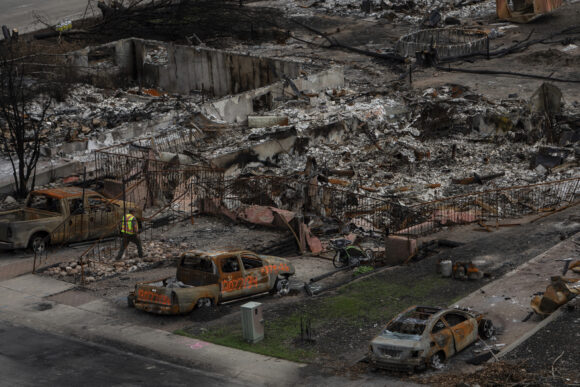With summer drawing to a close in Canada, the 2024 wildfire season is shaping up as one of the most destructive on record, largely due to the devastation caused by a blaze that ripped through a tourist town in the Canadian Rockies.
Based on total area scorched, the season ranks among the top six over the last half century. Even so, 2024 is turning out to be much less severe than last year – the worst on record – and not as bad as many had feared.
The total cost of wildfire damage this year surged in July when a third of the popular tourist town of Jasper, Alberta, was destroyed by a blaze. The fire caused an estimated C$880 million ($646.73 million) in insured damages, according to the Insurance Bureau of Canada.
In total, 5.3 million hectares (13.1 million acres) have burned to date in 2024, according to the Canadian Interagency Forest Fire Centre, and more than 600 fires are still raging across the country, mainly in British Columbia.
That makes 2024 the worst season since 1995, with the exception of last year, when a record-breaking 17 million hectares burned and released more carbon than some of the world’s largest-carbon emitting countries.
Wildfire season in Canada typically runs from April, when the snow melts, until September or October, with activity peaking in July and August. Climate scientists say average temperatures will rise in Canada as the world warms, leading to longer and more destructive wildfire seasons.
In April the Canadian government warned 2024 could potentially be another “catastrophic” wildfire season due on ongoing drought in the western provinces and forecasts of a hotter-than-average summer.
“We were bracing ourselves for what could potentially have been as bad a year as 2023,” said Alberta Wildfire information manager Christie Tucker, adding the province added a third night-vision helicopter, hired an extra hundred firefighters and declared an early start to the 2024 season as a precaution.
But dry conditions in June and July and an unusually high number of lightning-caused fires still sparked hundreds of blazes across the province, including the one that hit Jasper.
“That had a significant impact on everyone in Alberta,” Tucker added.
The threat of nearby wildfires prompted Suncor EnergySU.TO, Canada’s second-largest oil company, to curtail production at its Firebag site in northern Alberta, but the impact on oil supply was much less than some previous summers.
‘Zombie’ Fires
Wildfire agencies also had to contend with scores of so-called zombie fires that ignited last summer and burned throughout the long Canadian winter.
Fires From 2023, Smoldering Under Snow, Reveal Canada’s Dangerous New Reality
“I have never seen a year like that where there’s been so much fire that was because of a previous year. Some of them were the size of Prince Edward Island, they were just huge,” said Mike Flannigan, a wildfire expert and research chair at Thompson Rivers University in British Columbia.
Prince Edward Island, one of Canada’s Maritime provinces, has an area of 566,000 hectares, about the same size as the Toronto metropolitan area.
Flannigan estimated that almost half a million hectares, or nearly 10%, of the land burned in Canada in 2024 was due to overwintering fires from 2023.
Fewer evacuation orders and less widespread smoke – which last year affected millions of people across the northeastern United States as well as Canada – contributed to a sense that 2024 was a milder year for wildfires.
Kira Hoffman, a postdoctoral researcher and wildfire ecologist at the University of British Columbia, said western Canada was helped by a spell of cooler weather in late August that dampened some fire activity, but by historical measures, 2024 was still a very destructive season.
“It’s that shifting baseline syndrome. Last year was so extremely bad that this year we think only a third of that burning is pretty good,” she added. “But there’s nothing normal about it.”
Many experts warn the trend of longer periods of very hot and dry “fire weather” and increasingly bad wildfire seasons will continue as a result of climate change.
“If you look at either the total area burned or number of wildfires year over year or total damage caused by wildfires it goes up and down, but you draw the average trend line and everything is going up,” said Ryan Ness, director of adaptation at the Canadian Climate Institute.
($1 = 1.3607 Canadian dollars)
(Reporting by Nia Williams in Revelstoke, British Columbia; editing by Frank McGurty and Marguerita Choy)
Photograph: A worker walks in a devastated neighborhood in west Jasper, Alberta, Monday, Aug. 19, 2024, after a wildfire caused evacuations and widespread damage in the National Park and Jasper townsite. (Amber Bracken/The Canadian Press via AP)
Related:
- Canada’s 10 Worst Natural Disasters Totaled C$30 Billion in Annual Insured Losses
- Canada’s Insurance Sector Faces Deluge of Climate-Related Catastrophe Claims
- Insured Losses From Canada’s Jasper Wildfire Surpass C$880 Million
- Wildfire in Jasper National Park Could Burn for Months, Canadian Official Says
- ‘Zombie Fires’ Smoldering Near Oil and Gas Wells Threaten Canada’s Drillers
Was this article valuable?
Here are more articles you may enjoy.



 Main Street America Insurance Exits Personal Lines
Main Street America Insurance Exits Personal Lines  Risks Too Big for Insurers Just Fed a $200 Billion Market Boom in Captives
Risks Too Big for Insurers Just Fed a $200 Billion Market Boom in Captives  AM Best: Unfavorable Operating Performance Key Driver of Downgrades
AM Best: Unfavorable Operating Performance Key Driver of Downgrades  Hard Market ‘Supercycle’ Likely to Be Prolonged: Lloyd’s CEO Neal
Hard Market ‘Supercycle’ Likely to Be Prolonged: Lloyd’s CEO Neal 

